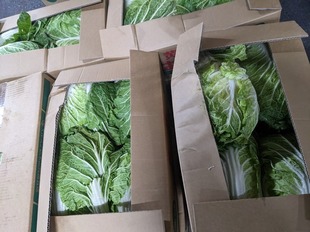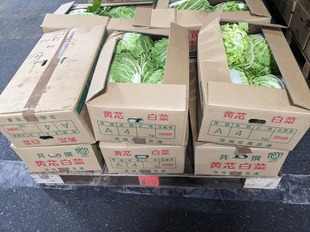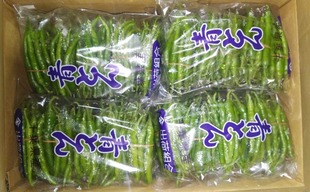Organic fertilizers are mainly derived from plants and animals, such as grass, oil cake, chicken manure, cow manure, and fish bone meal. When organic fertilizers are mixed into soil, they are decomposed by the microorganisms in the soil and begin to turn into nitrogen(N), phosphorus(P), potassium(K), etc., which are absorbed by the hair roots of plants. Because of this, they are not immediately effective, so I've heard that it takes several days for the effects to appear.
【Product name】
Princess yayoi
【Type】
Fragaria × ananassa Duchesne ex Rozier
【Wholesale area】
Funaki, Hokota City, Ibaraki Prefecture (Pure Green Agri Co., Ltd.)
【Origin of the name】
Originally, March was the period when the quality was likely to deteriorate, and it was named because it can maintain stable quality compared to other varieties.
【Main features】
The Japan-Indonesia Economic Partnership Agreement has been signed between the two countries on cooperation in a wide range of fields such as liberalization and facilitation of trade and investment, movement of natural persons, energy and mineral resources, intellectual property, and improvement of business environment. Under the agreement, it will come into effect on July 1, 2008. HE Heri Akhmadi, Ambassador Extraordinary and Plenipotentiary of the Republic of Indonesia to Japan and others visited Hokota City Hall in Ibaraki Prefecture on March 18, 2022 to deepen exchanges in fields such as agriculture and education, and met with Mayor Kishida. It seems. As of February 2022, 544 people are living in Hokota, where agriculture is flourishing, including accepting technical intern trainees from the country. At the meeting, opinions were exchanged on the actual situation of the trainees. Akhmadi said, “I wish I could deepen the cooperative relationship with Hokota City in agriculture and education.” He positions the acquisition of Japanese as important as a preparation for the trainees who come to Japan, and hopes that he will cooperate by dispatching instructors to educational institutions. As part of that, it seems that they have shown cooperation for a friendship city tie-up between local governments. Mayor Kishida seems to have agreed, “There are more Indonesian people in the city, so I would like to continue to have a connection.” At the same time, we are promoting special products such as melons and sweet potatoes, which boast the highest agricultural output by municipality in Japan. Indonesia is the ally of ASEAN and its headquarters is located in Jakarta. It is a leader in both name and reality in Southeast Asia, which is developing rapidly. In 2011, the Susilo Bambang Yudhoyono administration announced the master plan for large-scale infrastructure development plans, “Economic Development Acceleration / Expansion Master Plan (MP3EI)”. By increasing the nominal GDP by 2025 by about 6 times compared to 2010, it has set a high goal of becoming one of the world’s 10 largest economies. However, the plan is scheduled for 2015, along with six corridors running through the archipelago, Sumatra, Java, Kalimantan, Sulawesi, Bali-Nusa Tungara, and Papua-Marc, along with ICT, oil and gas, and steel. It was in the name of developing 22 major economic activities such as transportation vehicles. The investigation of the master plan began in May 2011, and the plan was approved by the steering committee of the Japanese and Indonesian government ministers in October 2012. By arranging sub-centers around Jakarta, the Jakarta metropolitan area as of 2030 with the goal of shifting from a centralized structure in the central city area of Jakarta to a multi-polar decentralized structure, alleviating traffic congestion and improving disaster prevention resistance. City vision is stipulated. In addition to the city vision, the overall plan for infrastructure development that the Jakarta metropolitan area should achieve by 2020 and the identification of 45 priority infrastructure projects, of which 20 early implementation projects that should be implemented early will be promoted. It was mentioned. In addition, the Indonesian economy is recovering in the headwind of the new coronavirus, and the inflation rate is also on a moderate upward trend. However, according to a recent survey, the economic growth rate in 2020 is -4.5%, which is the lowest after the war due to the influence of the new corona. Going back, the economic growth rate in 2019 is as low as -0.7%. This was a big negative due to the impact of the new Corona in the first quarter of 2019 after the decline due to the reaction to the introduction of the consumption tax in the fourth quarter of 2018. In addition, the economic growth rate in 2018 was 0.2%, the lowest in the last four years. Don’t forget to ask. According to the Rokko Regional Office Union Fire Department in Ibaraki Prefecture, a boat carrying two men who were conducting a water quality survey on Lake Hinuma overturned about 700 m off the south bank around 3:00 pm on February 6, 2022. It seems that a man walking along the lakeshore found men who were caught in a boat and asked for help, and asked a nearby fisherman to help him by phone. The two went to rescue on a fishing boat and cooperated to pull up the men. Unfortunately, one person died in the accident, and one was diagnosed with hypothermia but survived. At the time of the accident, the wind was strong and high waves were rising, and the temperature was low. At the presentation ceremony held at the same station in Awa, the city, the chief firefighter thanked the two men who carried out rescue operations under adverse conditions, saying, “Neither of them could have been saved without a prompt response from the two.” is doing. They told officials that they couldn’t pretend they didn’t know as a person. On March 7, we presented a letter of appreciation to two men in Minowa, Hokota City, for their achievements in saving lives in a water accident. Pure Green Agri® Co., Ltd. seems to be making various efforts to maintain the quality of agricultural products. It seems that the safety of agricultural products is ensured by sharing technical information on a daily basis, improving the level of each union member, and conducting quality inspections once a week and a variety review meeting. It owns a vast farm of over 50ha and seems to be confident in its supply. I hear that you are particular about providing a stable supply of high-quality vegetables and fruits. From J-PlatPat, Registration No. 4668895, Registration Date: May 2, 2003, Registration Bulletin Issue Date: June 3, 2003, Publication Date: September 19, 2002, Application Number: Commercial Application 2002 -72403, Filing date: August 9, 2002, Prior application right generation date: August 9, 2002, Renewal application date: June 21, 2013, Renewal registration date: October 22, 2013, Duration Expiration date: May 2, 2023, Trademark (for search): Pure Green Agri, Name (reference information): Pure Green Agri, Right holder, Name or Name: Pure Green Agri Co., Ltd., Address or whereabouts: Hokota Town, Kashima District, Ibaraki Prefecture, Law classification: 2001 revision of the law, International classification version display: 8th edition, Number of classifications: 1, Classification of goods and services and designated goods or services, similar group code, fruits, vegetables, seeds, sugar Crop, tree, grass, turf, dried flower, seedling, seedling, flower, grass, bonsai, 32D01 32D02 32D03 32E01 33C01 33D01. Registration number: No. 4846850, Registration date: March 18, 2005, Registration gazette publication date: April 19, 2005, Publication date: July 29, 2004, Application number: Commercial application 2004-61822, Application date : June 21, 2004, prior application right generation date: June 21, 2004, renewal application date: February 13, 2015, renewal registration date: February 16, 2016, expiration date: 2025 March 18, Trademark (for search): § Let’s eat vegetables, name (reference information): Yasaio-tabeyo, Yasaio-tabeyô, figures, etc. Classification: 26.4.4; 26.4.6; 26.4.18; 26.4.19; 27.5.1.30 27.5.1.40; 27.5.11; 27.5.21; 27.5.23.92, Law classification: 2001 revision of the law, International classification version display: 8th edition, Number of classifications: 1, Classification of goods and services and designated goods or services , Similar group code, fruit, vegetables, seeds, sugar crops, trees, grass, turf, dried flowers, seedlings, seedlings, flowers, grass, bonsai, 32D01 32D02 32D03 32E01 33C01 33D01. Registration number: No. 4918535, Registration date: January 6, 2006, Registration gazette issuance date: February 7, 2006, Publication date: June 9, 2005, Application number: Commercial application 2005-42160, Application date : April 26, 2005, prior application right generation date: April 26, 2005, renewal application date: January 20, 2016, renewal registration date: April 12, 2016, expiration date: 2026 January 6, Trademark (for search): Universal Konegi, Name (reference information): Banno Konegi, Manno Konegi, Banno, Manno, Figure, etc. Classification: 5.9.8; 5.9.23; 29.1.1.3; 29.1.3.2; 29.1 .12, right holder, Additional information: Colored, Law classification: 2001 revision of law, International classification version display: 8th edition, Number of classifications: 1, Classification of goods and services and designated goods or services, similar group code, green onion, green onion seeds, Green onion seedlings, 32D01 33C01 33D01. Registration No. 5886251, Registration Date: October 7, 2016, Registration Bulletin Issue Date: November 8, 2016, Publication Date: March 8, 2016, Application Number: Commercial Application 2016-19355, Application Date : February 9, 2016, date of prior application right: February 9, 2016, expiration date: October 7, 2026, trademark (for search): PGA. B \ PURE GREEN AGURI, name (reference information): Pijii Abi, Pijii, Pure Green Agri, Pure Green, Pure, Green Agri, Agri, Figure, etc. Classification: 5.3.11; 5.3.15; 5.3.16; 5.13.25; 26.1.2; 26.1.3; 26.1.20; 27.1.1; 27.1.12; 29.1.1.1; 29.1.1.2; 29.1.3.2; 29.1.11, Additional information: (591) Colored, Law classification: 2011 Law, International Classification Edition Labeling: 10th Edition, Number of Classifications: 1, Classification of goods and services and designated goods or services, similar group code, fruits, vegetables, seeds, sugar crops, trees, grass, turf, dry Flower, seedling, sapling, flower, grass, bonsai, 32D01 32D02 32D03 32E01 33C01 33D01, and 4 other trademark registrations were confirmed. Pure Green Agri seems to have acquired Hokota City’s original GAP (Good Agricultural Practice) and “Hokomaru GAP” certification. It seems that Hokomaru GAP visits union members’ homes to perform audits and guidance. In addition, I hear that each union member undergoes a pesticide residue inspection and soil inspection at least once a year. It seems that he participates in pesticide training and receives guidance on prevention of accidents caused by pesticides and proper use. In addition, the “cultivation management table” is published once a month on the website. In the cultivation management table, the house number cultivated from sowing to shipping, the fertilizer (chemical / organic) used there, and the name and amount of pesticides are described. You can easily access it from the QR code on the wrapping film. I hear that they are trying to grow safe and secure vegetables by disclosing information openly without hiding it. It seems that traceability is also in place. Representative Director: Mr. Takahiro Kimura, Union, Date of establishment, February 20, 2018 Sales start, Timing, May 2018 Items to be sold Mizuna greens, type of rape, spinach, garland chrysanthemum, chinese spinach, strawberry, cherry tomato, parsley trading Financial institution Joyo Bank. The producers introduced this time are Mr. Naoki Nogami Product name: Type of rape, Spinach, Variety: Spring Senbatsu, Mirage is good. “Yayoi Hime Strawberry” seems to be cultivating varieties with low acidity. It seems that they are paying attention to the ripeness at the time of harvest, aiming for the best condition when it arrives at the customer’s hand. It’s not too sweet and it seems like you want to bring it to your mouth one after another. “やよいひめ” : Application No. 14083 Date of application 2001/11/21 Date of publication of application 2002/03/25. Registration number 12576 Date of registration 2005/01/19 The duration of breeder’s rights is 20 years.(とねほっぺ × とちおとめ)に「とねほっぺ」を交配して育成されたものであり, 果実は円錘形で大きく, 果皮の色が明赤で休眠が短い促成栽培に向く品種である. 草姿は立性, 草勢は強, 草丈は高, 分げつの多少は中である. ランナー数は多, 葉色は緑, 葉の形状は上向き, 葉数は中, 葉柄の太さは太である. 果皮の色は明赤, 果形は円錘, 果実の大きさは大, 果肉色は橙赤, 果心の色は淡赤, 果実の光沢は良, 空洞は小である. 花の大きさはやや大,花弁の色は白, 花房当たり花数はやや少, 花柄の太さはやや太, 花柄長は長である. 果実の硬さはかなり硬, 無種子帯はかなり少, そう果の落ち込みは落込み小, そう果数は中, 果実の香りは少である. 季性は一季成, 開花始期及び成熟期は中, 開花位置は葉と同水準, 耐干性は中, 休眠性は短,可溶性固形物含量は高, 酸度は中, 日持ちはやや長, 輸送性はやや高である. 「とねほっぺ(Application No. 8380 Date of Application 1995/12/19 Date of Publication of Application 1999/03/12 Registration No. 7502. アメリカ合衆国導入種の選抜系統に「女峰」を交配して育成されたものであり, 葉色は濃緑で, 果実は円錘でかなり大きく, 成熟期が晩生の半促成栽培に向く品種である. 草姿は中間, 草勢は強, 草丈はやや高, 分げつの多少は少, ランナー数はやや多である. 葉色は濃緑, 葉の形状は上向き, 厚さはやや厚,葉数は中,葉柄の太さは太である. 果皮の色は鮮紅, 果形は円錘, 果実の大きさはかなり大, 果肉色は橙赤, 果心の色は淡赤, 果実の光沢は良, 果実の溝は無である. 花の大きさはやや大, 花弁の色は白, 花房当たりの花数は少である. 果実の硬さはやや硬, 無種子帯はほとんどなし, そう果の落ち込みは落ち込み小, そう果のアントシアニン着色及びそう果数は中, 果実の香りは少である. 季性は一季成, 開花始期及び成熟期は晩, 開花位置は葉より下, 可溶性固形分含量はやや高, 酸度及び日持ちは中である. 「女峰」と比較して,果実が大きい事, 開花始期及び成熟期が遅い事, 開花位置が葉より下である事等で, 区別性が認められたとある.)」と比較して, 葉色が淡い事, 果実の空洞が小さい事等で,「女峰」と比較して, 果皮の色が明赤である事, 果実が大きいこと等で区別性が認められるとある. 登録年月日,1999/11/25, 育成者権の存続期間, 20年, 育成者権の消滅日,2010/11/26.)」と比較して, 果皮の色が赤である事, そう果の落ち込みが, 中である事等で, 区別性が認められる. 対照品種「兵庫I-4号(紅クイーン)草姿は立性, 草勢は強, 葉の表面の色は緑, 頂小葉の縦横比は同等, 頂小葉の鋸歯の形は中間, 頂小葉の横断面の形は平面,葉柄の長さはやや長, 花の数はかなり少, 花の直径は中, 花弁の表面の色は白,果実の大きさは極大, 果実の縦横比は縦長, 果実の形は円錐形, 果皮の色は濃赤, 果実の光沢の強弱は強, そう果の落ち込みは落ち込み小, 果実の萼片の付き方は上向き, 果径に対する萼片の大きさはやや大, 果実の硬さは極硬, 果肉の色は淡赤, 果心の色は淡赤, 果実の空洞は無又は小, 季性は一季成りである. 対照品種「山口ST9号(Application No. 17707 Date of Application 2004/12/06 Date of Publication of Application 2006/02/15 Registration No. 15259. 出願者所有の育成系統同士を交配して育成されたものであり, 果実は円錐形でかなり大きく, 果皮の色は, 鮮紅の促成栽培に向く品種である. 草姿は立性, 草勢は強である. 葉色は濃緑, 葉の横断面の形状は平面, 光沢は中, 頂小葉の縦横比は同等, 基部の形は円形,鋸歯の形は中間, 葉柄の長さはやや長, ランナー数はやや少である. 花及び花冠に対する萼片の大きさは大, 花房当たりの花数は少である. 果実の縦横比は縦長, 大きさはかなり大, 果形は円錐, 果皮の色は鮮紅, 果実の光沢は中, そう果の落ち込みは落ち込み小, 萼片の着き方は反転, 果径に対する萼片の大きさはやや大, 果実の硬さは硬, 果肉色は橙赤, 果心の色は淡赤, 果実の空洞は無又は極小である. 開花始期は中, 成熟期はやや晩, 季性は一季成りである. 「とよのか」と比較して, 草姿が立性である事, そう果の落ち込みが小さい事等で,「さちのか」と比較して, 果皮の色が鮮紅である事, 果肉色が橙赤であること等で,「さつまおとめ」と比較して, 果肉色が橙赤である事, 果心の色が淡赤である事等で, 区別性が認められるとある. Registration date 2007/03/22 With 25 years of breeder’s rights.)」と比較して, 葉の表面の色が緑である事, 頂小葉の基部の形が鋭角である事,花の直径が中である事, 果実の硬さが極硬である事等で区別性が認められる. 対照品種「カレンベリー」と比較して, 葉の表面の色が緑である事, 頂小葉の基部の形が鋭角である事, 果実の大きさが極大である事, 果実の硬さが極硬である事, 果実の空洞が無又は小である事等で, 区別性が認められるとある.」と比較して, 頂小葉の大きさが大である事, 果柄の長さがやや長である事, そう果の落ち込みが落ち込み中である事等で, 区別性が認められるとある。“Awayuki” is said to be a mutation of “Sagahonoka”. Registration number 26987 Date of registration 2018/08/15 The duration of breeder’s rights is 25 years. Application Number 25717 Date of Application 2011/03/17 Date of Publication of Application 2011/07/26 Registration Number 22821. 草姿は中間, 草勢は強, 葉の表面の色は濃緑, 頂小葉の縦横比は同等, 頂小葉の鋸歯の形は中間, 頂小葉の横断面の形は平面, 葉柄の長さは中, 花の数はやや少,花の直径はやや大, 花弁の表面の色は白, 果実の大きさはやや大, 果実の縦横比は縦長,果実の形は円錐形, 果皮の色は淡橙, 果実の光沢の強弱は中, そう果の落ち込みは落ち込み小, 果実のがく片の付き方は水平, 果径に対するがく片の大きさはやや大, 果実の硬さはやや硬,果肉の色は橙赤, 果心の色は淡赤, 果実の空洞は無又は小, 季性は一季成りである. 出願品種「淡雪」は, 対照品種「和田初こい(Application Number 19557 Date of Application 2006/03/24 Date of Publication of Application 2006/11/17 Registration Number 18011. 草姿は開張性, 草勢は中, 葉色は緑, 葉の横断面の形状は平面, 頂小葉の縦横比は同等, 頂小葉の鋸歯の形は鈍鋸歯状, 葉柄の長さは短, ランナー数は少, 花の大きさはやや大, 花房当たりの花数は少, 果実の縦横比は縦長, 果実の大きさはやや大, 果形は長円錐, 果皮の色は淡紅, 果実の光沢は強, そう果の落ち込みは落ち込み小, がく片の着き方は離, 果径に対するがく片の大きさは小, 果実の硬さはやや軟, 果肉色は白, 果心の色は白, 果実の空洞は小, 季性は一季成りである。出願品種「和田初こい」は, 対照品種「章姫(Application Number 3766 Date of Application 1990/03/22 Registration Number 2991.「久能早生」に「女峰」を交配して育成されたものであり, 大果で乱形果が少ない促成栽培向き品種である. 草姿は立性, 草丈は高, 草勢は強である. 葉色は濃緑色, 葉の形状は平面, 葉数は少, 葉柄長は長である. ランナー数は多, ランナーの発根の早晩は中である. 花の大きさはやや大, 葯の大きさは中である. 果実の大きさは大, 果形は長円錘, 乱形果の形は双頭状, 第1果と第2果の果形の差は少, 無種子帯はほとんどなし, ネックの有無は無である. 果皮色は, 濃橙赤(JHSカラーチャート(General foundational juridical person Japan Color Research Institute: Dark reddish orange: 0707), へた下の着色の難易は中, 果実の光沢は良, 痩果(Achene)のおち込みは, ややおち込み小である. 果実の硬さは中, 果肉色は淡紅, 果心の色は白, 空洞はかなり小である. 可溶性固形物含量は高, 酸度はかなり低, 果実の香りは中である, 花芽分化期はやや早, 開花始期は早, 花(果)房当たり花(果)数は中, 成熟期はやや早, 成熟日数は中, 季性は時々四季成, 耐暑性及び耐低温性は高, 休眠性はかなり短である. うどんこ病及び萎黄病抵抗性は中である. 「女峰」と比較して, 果心の色が白である事, 酸度が低い事, 成熟期が早いこと等で,「久能早生(Application Number 510 Date of Application 1982/02/05 Registration Number 457.「旭宝」に「麗紅」を交配し, 石垣促成栽培用として育成されたもので,「麗紅」タイプ果実の早生品種である. 草勢は強, 分けつ性, 草丈は中である. 葉色はやや青緑, 小葉の大きさ, 葉柄の長さは中である. ランナー数はやや多い. 花柄長はやや短, 太さはやや太く, 花及び葯の大きさは中である. 果実の大きさは大, 果形は長円錘, 第1果と第2果の果形の差は少, 無種子帯はかなり少ない. 果皮色は鮮赤, 果の光沢は良, 痩果のおち込みは中である. 果実の硬さはやや硬, 果肉色は橙赤,空どうはやや小, 可溶性固形物含量, 酸度及び香りはともに中である. 花芽分化期, 開花始期及び成熟期はともに早, 花(果)房当たり花(果)数は中, 休眠性は短である. 「麗紅」と比較して, 草丈が低い事, 小葉の大きさが小さい事, 葉柄の長さが短い事, 花芽分化期, 開花始期が早い事, 花(果)房当たり花(果)数が少ない事等で, 区別性が認められるとある. 登録年月日, 1983/10/29, 育成者権の存続期間, 15年, 育成者権の消滅日, 1993/10/30であった。品種登録者, 萩原章弘氏, 静岡県静岡市, 同氏.)」と比較して, 草姿が開張性である事, 果皮の色が淡紅である事, 果径に対するがく片の大きさが小である事, 果肉色が白である事等で, 区別性が認められる. 対照品種「ふくはる香(Application number 15488 Date of application 2003/02/21 Date of publication of application 2003/09/08 With registration number 13640.「章姫」に「さちのか」を交配して育成されたものであり, 果実は長円錐形で大きさは中, 果皮の色が鮮赤の促成栽培に向く品種である. 草姿は立性, 草勢は強である. 葉色は濃緑, 葉の横断面の形状は軽く上に湾曲, 光沢は中, 頂小葉の縦横比は縦長, 基部の形は鋭角, 鋸歯の形は中間, 葉柄の長さは長, ランナーの数はやや多である. 花の大きさは中, 花冠に対するがく片の大きさは大,花房当たりの花数はかなり少である. 果実の縦横比はかなり縦長, 大きさは中, 果形は長円錐,果皮の色は鮮赤, 果実の光沢は強, そう果の落ち込みは落ち込み中, がく片の着き方は離, 果径に対するがく片の大きさは大, 果実の硬さはかなり硬, 果肉色は淡紅, 果心の色は淡赤, 果実の空洞は小である. 開花始期はやや早, 成熟期は中, 季性は一季成りである.「章姫」と比較して, 花房当たりの花数が少ない事, 果心の色が淡赤である事等で,「女峰」と比較して, 花房当たりの花数が少ない事, 果形が長円錐である事等で, 区別性が認められるとある. Registration date 2006/02/27 The duration of breeder’s rights is 25 years. Variety registrant, Sugitsuma Town, Fukushima City, Fukushima Prefecture, Registered cultivar breeder, Mr. Otake, Mr. Nii, Mr. Kayahara: The Differentiation Strategy’s Effective to the New Breed of the Strawberry Bred in Fukushima Prefecture: Fukushima Agricultural Technology Center」と比較して, 草姿が開張性である事, 果皮の色が淡紅である事, 果径に対するがく片の大きさが小である事, 果肉色が白である事等で, 区別性が認められるとある. Registration date 2009/03/19 Confirmed that the duration of breeder’s rights is 25 years. Variety registrant, Miyoshi Agritech Co., Ltd., Kobuchisawa, Hokuto City, Yamanashi Prefecture, Registered cultivar breeder, Mr. Yasuji Wada.) It is said that distinction is recognized because the color is orange-red. Registration date 2013/12/05 Confirmed that the duration of breeder’s rights is 25 years. Variety registrant, Mr. Toru Yamashita, Shibushi City, Kagoshima Prefecture, Registered cultivar breeder, Mr. Almost no sourness is felt, and the sweetness seems to smell the mouth first. Since the flesh is a little firm, I got the impression that the texture with a moderate texture was comfortable. The fruits are slightly elongated cones, slightly larger and relatively uniform. I think the two producers have a good reputation for growing strawberries in the production area and are famous. Now, let me introduce the place where the producer’s field is located. “Hokota City, Ibaraki Prefecture,” Located in the Rokko region in the southeastern part of Ibaraki Prefecture, it is one of the leading agricultural areas in Japan, blessed with a vast Pacific Ocean and abundant green land. Agriculture, which takes advantage of the flat terrain and mild climate, is a key industry and a food supply area for the entire metropolitan area. Not only fruits such as melons and strawberries, which are famous nationwide. Japanese mustard spinach, spinach, mizuna greens, tomato, carrot and other vegetables, which are known all over the country for many items. Oodo’s Sapindus mukorossi Gaertn(Indian soapberry): City natural monument – The light candy-colored fruit is impressive. When peeled, a black seed appears from inside. The seeds are used for the black balls on the wings of the New Year play battledore and shuttlecock. The real skin was used as a detergent in the past. That’s because when you rub it in water, bubbles form and it’s suitable for removing dirt. Minowa : ‘Tokushuku Castle: Designated as a city historic site’, Built by Mr. Tokushuku’s first Chikamoto-Ko at the end of the Heian period. He had been Shimotsuke no jo (local official for the Shimotsuke Province) before, but, by his merit of hunting down TAIRA no Masakado-Ko, he was promoted to Jushiinoge (Junior Forth Rank, Lower Grade) and appointed to the post of kokushi (provincial governors) for the Shimotsuke and Musashi Provisions as well as Chinju-fu shogun (Commander-in-Chief of the Defense of the North) and increased his power. After passing through the castle monument, climb the stairs at the entrance, and you will see a waist from the southwest to the south on your right. When you climb the stairs, you will find the main shrine, the Inari Shrine, the stone monument of Tokushuku monument to the memorial service, and the Hokyointo. etc. Father Narimoto Kashima-Ko is the 7th generation from Taira no Kunika(Takamochi did not return to Kyoto after he served out his term, and his sons Kunika filled the post of Hitachi no daijo (Senior Secretary of Hitachi Province) and Yoshimasa of Chinju-fu shogun (Commander-in-Chief of the Defense of the North)), who follows the tradition of Emperor Kanmu, and governs Kashima District at the will of the Hitachi Daijo clan. Tokushuku’s second generation(The ancestor of Mr. Anbo. Based in Kamata Castle Ruins)Mr. Hidemoto’s eldest son, Toshimoto-Ko, transferred the area including Awa and Hokota. In February 1336, he proceeded into the Urizura-jo Castle, and fought against Sadayoshi SATAKE-Ko and others of the Northern Court side, in cooperation of the Naka-Kawanobe family group lead by Haruhisa ODA, Michitoki NAKA-Ko, the Daijo family group lead by Tsuneyasu HIROHASHI-Ko, Takamoto DAIJO-Ko, and Nobumasa NAGAOKA-Ko, and the Chiba family group lead by Tanehira SOMA-Ko, among others. In 1486, when Tokushuku was the 9th Michimoto, he was attacked by Mr. Edo(Shigemichi fiercely attacked the Daijo clan who had their base in Fuchu), who is based in Mito Castle. etc. 歴史 / 伝統文化,『鉾神社夏祭り大祭』は, およそ400年以上の歴史をもつ鉾田最大の祭礼で, 8月の最終の金, 土, 日に行われる. 勇壮な神輿とともに, 山車や獅子舞が市内を巡行し, 街は, お囃子の音に包まれる.『厳島神社(Itsukushima (Miyajima): Island centering on Itsukushima-jinja Shrine existing in Hatsukaichi City, Hiroshima Prefecture.)』は, 子生の弁天様の名で親しまれている神社で, 1078年(承暦2年), 安芸宮島の厳島神社より分霊を迎えられたのが始まりと言われている. 貴重な建築物で, 県指定の文化財となっている.『無量寿寺』は, 806年(大同元年), 平城天皇(When Emperor Heizei had a conflict with his brother, Emperor Saga, and tried to move the capital in Heian kyo back to Heijokyo, Emperor Saga petitioned the deity that he would dedicate his daughter to Kamo no Okami (a guardian god of the capital) as ‘Areotome’ (a woman to join in the ceremony held at the Kamo-jinja Shrine for welcoming gods) if he had a chance of winning.)の勅願所として建立された. 1221年(承久3年)から3年間, 親鸞和尚(Selected and described by Shinran, the founder of the sect)が, この寺で教えを広めたと言われる.『大儀寺』は, 684年(貞享元年)仏頂禅師が, 廃庵となっていた, “大儀庵” を復興させ改められた. 禅師は, Mr. “Basyo Matsuo(Mr. Kigin KITAMURA’s one’s Student)” It is told that there was a friendship with. “Shaka Nyorai Statue” is valuable as a nationally designated important cultural property of “Okura Fukusenji”. It is made of cypress parquet and the statue height is 165.5 cm. Twelve Buddha statues are also embossed in the backlit part. , Created at the end of the Kamakura period. Developed during the Edo period as a key point for land and water transportation connecting Edo with the Tohoku and Hitachi regions. The traffic of humans and horses and the distribution of goods centered on marine products became popular, and agricultural products were also shipped to the Edo area. Minowa ; “箕輪”(Former Asahi Village), It is right next to the producer’s field. Mizu shrine and Yagami shrine: It’s small, quietly blended into the area, and has an old-fashioned atmosphere like “the god of the village Guardian”. When you go up the old stone stairs, there is a stone monument next to the shrine, and the origin of the shrine is engraved. Yamato takeru no mikoto is eastern expedition – Take a boat from Kashima City Tsunoori (formerly Ono Village) and land near Kamigama, Hokota City. After that, I went inland and took a rest for a while on the south bank of Hinuma(Brackish water lake of Nakagawa water system). Then, when he departed, he gave the villagers a Crossbow (a stone bow that shoots an arrow). It is said that this shrine was dedicated to the villagers and built a small shrine. Nihonshoki(Chronicles of Japan); 日本武尊, Kojiki(Records of Ancient Matters); 倭建命(Yamatotakeru no Mikoto), Hitachi Fudoki (description of the culture, climate, etc. of Hitachi province; approx. 720 CE) ; 倭武天皇. Various names and notations are confirmed in these documents. Legend has it that he wore one of the three sacred treasures, the Nagi-sword, and worked hard to settle the nations. The route and place of stay of Tosei are different between Kojiki and Nihonshoki. There are various theories about this, but there was also a legend that stopped by this place near Hinuma. 造谷 – 厳島神社本殿 : Konaji Ground -Worshipped deity ; 市杵島姫命(A pillar of the Three Goddesses of Munakata, the god of water.)- It is said that the company welcomed the spirit from Itsukushima in Aki on New Year’s Day in 1265. Inferred from the fact that it is closely related to the HITACHI Mr. Hei clan. Naturally, it can be considered from the former Asahi village area. “御累書年代記写”, 1809 ; “承暦二年(Joryaku, 1078年)子生山弁才天之此訳造谷村 ‘龍蔵院 硯録に在之由也” – Benzaiten(Also wealth and water)was enshrined in the land of Tsukuriya. However, Nakajima and Yatsuda(Reservoir)theory are influential. Transferred to a Konaji – In August 1672, everything from the Shrine building to the trees in the precincts was burnt down. Therefore, there are no records related to shrines. The main shrine was designated as a prefectural cultural property in March 1968. The hall of worship was designated as a village cultural property in September 1973. Pent roof built atop the stairs of a shrine or temple : The dragon sculpture is made of one piece of wood -Middle Edo. 樅山神社, 愛宕神社大権現 : Founded in 807 -A copy of the building tag of 853 remains. 吉田(大掾; 鹿嶋)“成幹”氏の子,(Eldest son)徳宿親幹- Ko(Kunika style)Later, Disappeared in the 1486 Momiyamagahara battle. It was erected and restored in 1600, and was fully repaired in 1983 – City designated cultural property. “Hokomaru” from Hokota City, Ibaraki Prefecture, was born from the desire to make everyone’s hearts round. Hokota’s “Ho” character is the motif of the mascot character. It was born in 2008 and has gained popularity through open recruitment. Designated tangible cultural property : 県, 厳島神社 本殿, 子生,県, 無量寿寺 本堂, 鳥栖, 県, 無量寿寺 鐘楼, 鳥栖, 県, 無量寿寺 山門, 鳥栖, 市, 主石神社 本殿, 大和田, 市, 厳島神社 拝殿, 子生, 市, 樅山神社 本殿, 樅山, 市, 玉沢稲荷神社 本殿/ 拝殿, 冷水, 市, 八幡神社 本殿, 飯島, 市, 息栖神社 本殿, 二重作, 市, 永福寺薬師堂, 上幡木, 市, 鉾山神社 本殿, 上幡木, 市, 近津神社 本殿, 大蔵, 市, 光福寺 楼門, 梶山, 市, 八幡神社 拝殿, 飯島, 絵画 : 国, 紙本著色拾遺古徳伝, 鳥栖, 県, 紙本墨画維摩居士像 附 徳川光圀 書状4通, 松平頼救 跋1枚, 大蔵, 工芸品 : 市, 石祠 祭神市杵島姫命, 鹿田, 彫刻 : 国, 木造 釈迦如来立像, 大蔵, 県, 木造 如意輪観世音坐像, 汲上, 県, 銅造 薬師如来立像, 梶山, 市, 金銅大仏坐像, 借宿, 市, 銅像 三体仏, 安房, 市, “石造 諏訪青山の地蔵菩薩, 柏熊, 市, 木造 薬師如来坐像, 柏熊, 市”, 木造 如意輪観世音坐像, 安房, 市, 木造 千手観世音立像, 烟田, 市, 木造 両脇侍立像, 烟田, 市, 木造 宝冠釈迦如来坐像, 青柳, 市, 木造 十一面観音坐像下, 冨田, 市, 木造 薬師瑠璃光如来座像, 阿玉, 市, 木造 十一面観音立像, 札, 書跡 : 無量寿寺御文書, 鳥栖, 市, 医書(瘍医大全), 徳宿, 考古資料 : 市, 弥生式ツボ, 徳宿, 市, 烟田氏の墓碑, 烟田, 市, 縄文, 注口土器, 塔ケ崎, 市, 梶山古墳群4号墳出土遺物, 汲上, 記念物 : 史跡 : 市, 三階城跡, 安房, 市, 徳宿城跡, 徳宿, 市, 中居城跡, 中居, 市, 白鳥の里, 中居, 市, 大峰山古墳群, 中居, 名勝 : 市, 大儀寺境内全域, 阿玉, 天然記念物 : 県, 無量寿寺のボダイジュ, 鳥栖, 県, お葉つきイチョウ, 中居, 市, 沼尾神社の欅, 徳宿, 市, 諏訪神社樹叢, 安房, 市, 安祥寺の榧並木, 安房, 市, 谷越神社樹叢, 飯名, 市, 無量寿寺樹叢, 鳥栖, 市, かたくり群生地, 青柳, 市, 無量寿寺の斑入銀杏, 鳥栖, 市, 無量寿寺の焼榧, 鳥栖, 市, 三渡神社の御神木, 秋山, 市, 大戸のムクロジ, 大戸, 市, 秋山の榊, 秋山, 市, 野友の椎, 野友, 市, 青柳のもち, 青柳, 市, 国都神神社御神木「椎」, 上太田, 市, 飯田「もち」, 鹿田, 市, 勝下 「イスノキ」, 勝下, 市, 樅山「ヒサカキ」, 樅山, 市, 八幡神社樹叢, 飯島. The former Funaki Elementary School was closed in the spring of 2016. The old Yoshino cherry tree that blooms in the middle of the schoolyard is a famous cherry blossom that goes along with the history of the school. According to “Public Relations Hokota”, the school opened in 1909, and the cherry blossoms in the center of the schoolyard are old trees over 100 years old. Currently, the school building has been demolished, but the cherry blossoms seem to remain. The nearest stations in the vicinity are Kashima Asahi Station (Kashima Rinkai Railway): Distance: 4167 m (52 minutes on foot), Tokushuku Station (Kashima Rinkai Railway): Distance: 4605 m (57 minutes on foot).

From Agriknowledge, Registration date August 27, 2019, Gunma Prefectural Agricultural Technology Center (Nishiobokata Town, Isesaki City) Research Report, Page 16, Abstract, Strawberry variety “Yayoihime STRAWBERRY” Cheap and simple facility cooling to seedling raising greenhouse As a method, we examined the effect of roof sprinkling using the heat of vaporization of water sprinkled from the sprinkling tube installed on the roof of the green house. By sprinkling the roof of the nursery house during the daytime on a sunny day, it was possible to suppress the rise in the temperature inside the house by an average of about 2 ° C. In the year when the temperature in early September was normal or above normal, the flower bud differentiation of strawberries was promoted by watering the roof, the harvest start time was earlier, and the yield within the year increased. The G-Analyze & PR team analyzes agricultural and livestock products produced in Gunma prefecture for ingredients related to health that are attracting a lot of attention from consumers, conveys them to consumers, and reflects consumer reactions in production sites and technical guidance. It seems to be an effort to make it. It is composed of staff involved in test research, sales promotion, and production promotion of agricultural and livestock products, centered on the Gunma Prefectural Agricultural Administration Department.
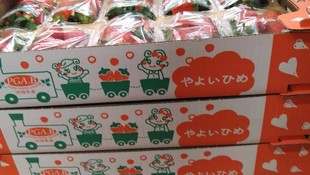
In July 2010, the Pure Green Agri Cooperative was certified by Hokomaru GAP. The contents of process control are accurately recorded in a wide range of areas such as correct fertilizer management and use, safe pesticide use, safety management of agricultural workers, and safety of residual pesticides at least once a year. While providing appropriate guidance and advice, certification will be given only to businesses that are recognized as appropriate. Based on the records, if it leads to the improvement of agricultural work, it will lead to cost reduction and quality improvement, the evaluation of the production area will increase, and the price and transaction volume will increase. We apply organic fertilizers and work on safe and secure agriculture.
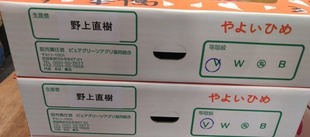
It has a high sugar content and a good taste. The pericarp is bright red, and the fruits are large and delicious even in the latter half of the harvest. The skin is hard and has a long shelf life. In addition, it is highly transportable. The variety name “YAYOIHIME STRAWBERRY” is Yayoi (Mars is the god of military and farming in ancient Rome. In ancient Rome, March is the month when the climate improves and military action begins, and at the same time, farming. It seems that it was the month when the strawberry began. Therefore, it seems that the ancient Romans praised the god Mars every March. It is said that March became March as the origin of the word.) After March. We hope that the excellent characteristics and abilities of this variety will be exhibited, and that Yayoi has historically meant the origin of agricultural culture, and that this variety will be the starting point and driving force for strawberry production in Gunma Prefecture.
